In Review: Ran Hwang at The Baker Museum by Janice T. Paine
March 17, 2023
Repetition is the spice of life for Korean-American artist Ran Hwang. She practices an art of obsessive accumulation, deploying buttons, beads and crystals with a fierce exactitude. Impaled on pins, these tiny sewing notions coalesce into culturally laden imagery of plum blossoms, Buddhas and architectural edifices. Some of the slow, painstaking work of pounding her minute materials into place is now done by studio assistants. However, earlier in her career, Hwang spent many hours ritualistically pinning beads and buttons directly onto gallery walls, tapping them with a hammer a self-prescribed number of times, to fashion mural-like temporary installations. Eventually, though, she moved on to using plexiglass and other types of panels for support.
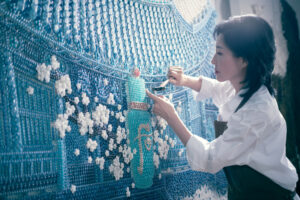
Ran Hwang. Courtesy of the artist.
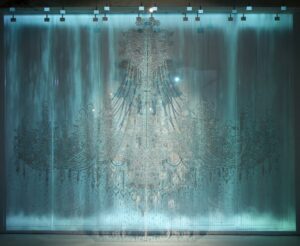
Ran Hwang, Garden of Water, 2010. Crystals, beads, and pins on Plexiglas, video projection, 91 x 118 inches. Courtesy of the artist.
As seen in the exhibition Ran Hwang: Becoming Again at The Baker Museum in Naples, Florida (on display November 2, 2022–January 8, 2023), Hwang’s art ranges from wall-mounted mixed-media reliefs and sculptural objects to complex, immersive installations. Her work resists classification but often contains interesting allusions to fabric, fashion and fiber art. Her visual voice can be very quiet, as in Contemplation Time. This relief takes the form of a life-sized seated bodhisattva (in Buddhist thought, an enlightened being or one who is on the path to spiritual awakening). Constructed from thousands of pink paper buttons, beads and pins, the surface of this artwork is restrained, elegant and meticulously composed. There are subtle shifts in color; the buttons gradually shade from light to darker pink at the bottom edge as they trail off into oblivion. Hwang’s ability to manipulate tiny bits of fragile paper to create dimensional effects and conjure internal shapes, such as the smoothly curving lines of the bodhisattva’s facial features or the draped fabric across the being’s legs, is phenomenal.
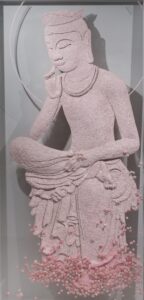
Ran Hwang, Contemplation Time, 2014. Paper buttons, beads, and pins on Plexiglas, 93 x 45 inches. Courtesy of the artist.
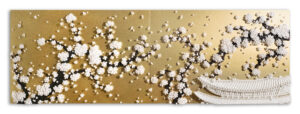
Ran Hwang, Healing Forest, 2021. Buttons, pins, and beads on wooden panels, 47.2 x 141.66 inches. Private collection, New Jersey.
An architectural fantasy called The Beginning of the Bright is set in a light box that bathes the background in a clear blue light. Its composition interlaces imagery drawn with photographic precision from various stately monuments—the Eiffel Tower and Arc de Triomphe in Paris and the elevations of several ancient Korean palaces—emblematic of Eastern and Western civilizations. The low-relief forms are constructed of paper buttons and innumerable stamped-out letters of the Korean alphabet, all made of thick mulberry paper. First exhibited in 2015 at UNESCO headquarters in Paris in celebration of International Literacy Day, the overall feeling of the piece is dispassionate, as if the need to communicate an elaborate program of meaning related to language and literacy took precedence over ephemeral poetry.
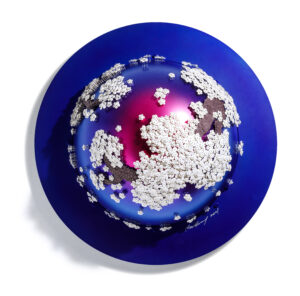
Ran Hwang, Nothing Forever PB, 2021. Paper buttons, beads, and pins on acrylic dome, 31.75 x 31.75 x 11.8 inches. Courtesy of the artist.
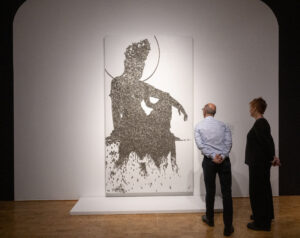
Ran Hwang, Rest II (installation), 2009. Metal buttons and pins on Plexiglas, 108 x 60 inches. Courtesy of the artist.
The show’s namesake piece, Becoming Again, reconfigured a large-scale installation that was first exhibited in Singapore in 2017. Suffused with light and color via video projections in a darkened gallery, the installation was accompanied by a soundtrack of traditional Korean music. A central “canvas” made of translucent plexiglass panels dominated the room, embellished with meandering patterns of blossom-covered branches and spiderwebs affixed to the surface with pins. Activated by video images of drifting petals and shadowy flying birds, this central screen offered a sweeping, romantic evocation of the changing seasons as part of the cyclical nature of life. The theme carried over to peripheral elements of the installation, which referenced Korean marriage ceremonies through video images of a couple in traditional wedding garb and a gathering of antique jokduri. Once worn as part of Korean women’s wedding headdresses, these colorful, beaded fabric caps resemble shrunken pillbox hats. I left wondering exactly what the artist hoped to convey about the rituals of marriage in this context, apart from presenting a dreamy vision of the past that whispers, “The more things change, the more they remain the same.”
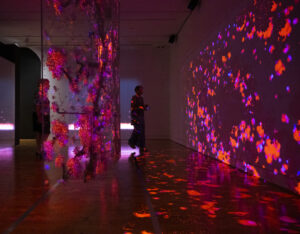
Ran Hwang, Becoming Again (installation), 2017. Paper buttons, beads, crystals, and pins on Plexiglas, video projection, 94.2 x 165.66 inches. Courtesy of the artist.
–Janice T. Paine is an art critic and writer based in Naples, Florida.
